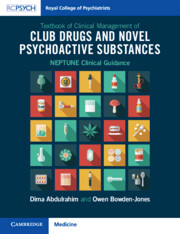 Textbook of Clinical Management of Club Drugs and Novel Psychoactive Substances
Textbook of Clinical Management of Club Drugs and Novel Psychoactive Substances Book contents
- Textbook of Clinical Management of Club Drugs and Novel Psychoactive Substances
- Textbook of Clinical Management of Club Drugs and Novel Psychoactive Substances
- Copyright page
- Contents
- Acknowledgements
- Part I Introduction and Background
- Part II Drugs with Primarily Depressant Effects
- Part III Drugs with Primarily Stimulant Effects
- Chapter 8A Introduction to Stimulant Club Drugs and Novel Psychoactive Substances
- Chapter 8B Amphetamine-type Stimulants: An Overview
- Chapter 9 ‘Ecstasy’: MDMA (3,4-Methylenedioxy-N-Methylamphetamine), MDMA Analogues and Drugs with Similar Effects
- Chapter 10 Methamphetamine
- Chapter 11 Synthetic Cathinones
- Part IV Drugs with Primarily Hallucinogenic Effects
- Part V Synthetic Cannabinoid Receptor Agonists
- Part VI Concluding Remarks
- Index
- References
Chapter 11 - Synthetic Cathinones
from Part III - Drugs with Primarily Stimulant Effects
Published online by Cambridge University Press: 06 October 2022
- Textbook of Clinical Management of Club Drugs and Novel Psychoactive Substances
- Textbook of Clinical Management of Club Drugs and Novel Psychoactive Substances
- Copyright page
- Contents
- Acknowledgements
- Part I Introduction and Background
- Part II Drugs with Primarily Depressant Effects
- Part III Drugs with Primarily Stimulant Effects
- Chapter 8A Introduction to Stimulant Club Drugs and Novel Psychoactive Substances
- Chapter 8B Amphetamine-type Stimulants: An Overview
- Chapter 9 ‘Ecstasy’: MDMA (3,4-Methylenedioxy-N-Methylamphetamine), MDMA Analogues and Drugs with Similar Effects
- Chapter 10 Methamphetamine
- Chapter 11 Synthetic Cathinones
- Part IV Drugs with Primarily Hallucinogenic Effects
- Part V Synthetic Cannabinoid Receptor Agonists
- Part VI Concluding Remarks
- Index
- References
Summary
The natural analogue to synthetic cathinones is the active compound in the leaves of the khat plant (Catha edulis), which have been chewed for centuries in parts of Africa and the Arabian Peninsula for their stimulant properties.1 Synthetic cathinones are also prescribed medications, such as bupropion, Wellbutrin®.
- Type
- Chapter
- Information
- Textbook of Clinical Management of Club Drugs and Novel Psychoactive SubstancesNEPTUNE Clinical Guidance, pp. 240 - 266Publisher: Cambridge University PressPrint publication year: 2022


